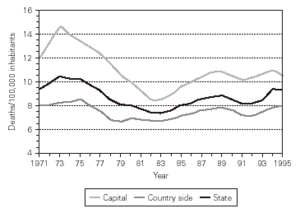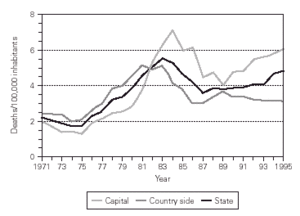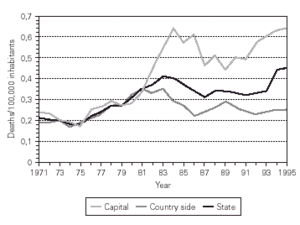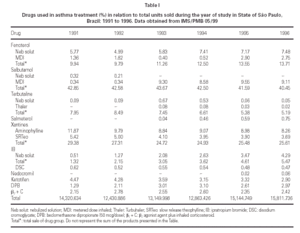INTRODUCTION
The first asthma death report was by Arateus the Capadocian when referring to the possibility of suffocation due to asthma (1). In the XIIth century, Maimonides (1136 to 1204 A.C.), a physician and philosopher, stated in his treaty on bronchial asthma "...if the prescribed treatment of bronchial asthma is not complied with and the patients' habits and desires are satisfied in an indiscriminate way, the frequency, severity, and duration of the crisis will increase reaching a peak and end in death". He defended an individualized treatment "...due to idiosyncrasies, a patient can present relief drinking cold water, while another can die for this reason" (1).
After the second half of the XXth century, asthma has been considered as a public health problem, mainly due to the increase in its mortality rate, which has been observed in several countries (1-9). In spite of improvement in knowledge of asthma pathophysiology and acquisition of new specific medicines, asthma morbidity and mortality have been increasing (1-9).
Asthma mortality rates have been widely variable in different areas and countries. In New Zealand, the rate reached 3.63 deaths/100,000 inhabitants in 1979-1981, decreased later to 2.67 in 1982-1990 and showed a further significant reduction between 1990 and 1992 (10). In other countries, these rates have also decreased during the evaluated period of time (3, 11-13).
In Latin America, mainly in Brazil, data on asthma mortality are scarce. In a recent study, Chatkin et al evaluated asthma mortality rates in Rio Grande do Sul (southern Brazil) in the age range of 5 to 19 and 20 to 39 years and observed its increase from 0.04 and 0.39/100,000 and 0.28 to 0.75/100,000 inhabitants respectively (14). Similar data were observed by Rosário Filho (15) in the state of Paraná, also in the southern region of Brazil.
Several causes have been pointed out as being responsible for the observed asthma mortality increasing in the last years in several parts of the world: incidence and consequently prevalence of asthma had increased, changes in therapeutic approach, changes in diagnosis criteria, better conditions for diagnosis and changes in the International Disease Classification (IDC) (16).
We evaluate in this study the trends of respiratory disease (RD) and asthma mortality rates in the total population and in the age group of 5 to 34 years, from 1970 to 1996, in the state of São Paulo, its capital and country side. The capital of the state of São Paulo is a big urban center with high levels of atmospheric polution, and large poverty areas.
MATERIAL AND METHODS
Population and death data, regarding the total population and the age group of 5 to 34 years, were supplied by the Data Analysis System State Foundation of São Paulo (SEADE) from 1970 to 1996 (17). Populational data were obtained from demographic censuses (1970, 1980 and 1991) with interpolation for the other years and adjusted for each age group (18). We considered only those deaths that were attributed to asthma (9th IDC: 493) and to respiratory diseases (9th IDC: 460 to 519). Data from the country side of the state were obtained by subtracting the data regarding the capital from those total of the state.
To eliminate undesirable fluctuations, very common in long temporal series studies, we used the mobile mean with triennial intervals (19). The mean triennial coefficients were calculated by the division of the sum of the three-year coefficients by three. The degree of asthma mortality within RD mortality was calculated by the ratio between both rates and expressed as percentatge. We also studied the sex ratio in each age group, in the capital and country side, by the division of male by female mortality coeficients. From 1991 to 1996, sales of medicines usually used in the asthma treatment were verified (20).
RESULTS
In 1991, the total population of the state was 31,257,651 inhabitants (30.3 % of them in the capital) 56.8 % of them being between 5 and 34 years old (30.0 % of them in the capital). In the years 1970 and 1980, the capital had 33.5 % of the total population and 33.0 % of the 5 to 34-year-old population of the states.
Between 1970 and 1996, 522,289 RD deaths occurred in the state (capital = 37.4 %) and 36,946 of them in the age period of 5 to 34 years (capital = 32.7 %). Asthma deaths represented 2.1 % of the total RD deaths (capital = 37.3 %). In the state, in the group of 5 to 34 years 1,246 asthma deaths were recorded (capital = 43.6 %) which represented 11.3 % of the total asthma deaths in the general population and 3.4 % of the RD deaths in the age group of 5 to 34 years.
The RD mortality in the state started in 1970 with 9.33 deaths/100,000 inhabitants, reached a maximum in 1973 (10.44 deaths/100,000 inhabitants), and finished the period (1996) with 9.3 deaths/100,000 inhabitants. During the whole period the mortality rates were higher in the capital (fig. 1). Asthma deaths represented about 2 % of the RD deaths in the 70's, reached 5 % in 1980, decreased to 3.5 % in 1987 and ended the period reaching 4.48 %. The increase was higher in the capital: 7.14 % in 1984 and 6.1 % in 1996 (fig. 2). After the 80's, the percentage of asthma as a cause of death of RD was higher in the capital (fig. 2).
Figure 1.--Trienal mean respiratory disease mortality rates (9th IDC: 460-519) in the age group of 5 to 34 years in the state of São Paulo (Capital and Country side): 1970 to 1996.
Figure 2.--Percentage os asthma deaths (9th IDC: 493) in relation to the by respiratory diseases deaths (9th IDC: 460-519) in the age group of 5 to 34 years in the sate of São Paulo (Capital and Country side): 1970 to 1996.
In the state, asthma mortality in the age group of 5 to 34 years, was in 1970 0.21 deaths/100,000 inhabitants ascending to 0.41 in 1983 staying stable until the end of the studied period (0.45 deaths/100,000 inhabitants). However, analyzing the data from the capital there was a significant increase up to 1984 with 0.64 deaths/100,000 inhabitants, a fall to 0.45 in 1989, and concluding the period with 0.64 deaths/100,000 inhabitants (fig. 3).
Figure 3.--Trienal mean asthma mortality rates (9th IDC: 493) in the age group of 5 to 34 years in the state of São Paulo (Capital and Country side): 1970 to 1996.
Considering sex, practically during the whole period of the study, asthma mortality rates were higher in men than in women, in the country side and in the capital. The analysis of asthma mortality rates according to different age periods (5-9; 10-14; 15-19; 20-24; 25-29; and 30-34 years), documented higher values for the country side and for the capital in the age period above 15 years.
The sales of drugs usually administered to asthmatic patients are shown in table I, and an increase in the total sales was observed in 1995 and 1996. The drugs mainly used in the treatment of acute asthma exacerbations were responsible for 91.44 % of the sales in 1991 and 91.18 % in 1996. Beta2 agonists, mainly salbutamol, were the most sold. Of the group of nebulized solutions, fenoterol showed a significant increase in sales during this period. Among metered dose inhaler sales, salbutamol was the most sold. Available after 1993, salmeterol sales have been increasing and reached 0.75 % of the total of medications sold in 1996. Xanthine sales showed a slight fall, mostly regarding the slow release formulations. On the other hand, the sales of ipratropium bromide increased four times between 1991 and 1996. In contrast, controller medications like inhaled glucocorticosteroids, showed very low consumption. We observed a reduction in ketotifen and disodium cromoglycate. The sales of beclomethasone dipropionate (BDP) increased about twice during the period of the study; on the other hand, the association of BDP with a short acting beta 2 agent remained stable during the study period.
DISCUSSION
The knowledge of mortality rates of a specific disease in a certain population is an important issue in epidemiological studies. Frequently long periods of monitoring allows investigators to establish and discover which factors eventually could be related to mortality rates. In this study we evaluated asthma and RD mortality rates, in the state of São Paulo during the years 1970 to 1996. In this period of time, deaths were registered according to the place of residence. This fact reduced deaths underregistrations, as observed in other countries.
The International Model of Death Certificate used in Brazil, as in other parts of the world, began in 1950 (21). In the present study, we considered only deaths registered being due to asthma and RD as basic cause. In spite of criticism regarding reliability of filling out death certificates, in the state of São Paulo, 90 % to 100 % of the population are covered by regular mortality information, and not well-defined causes of death are less than 10 % (22).
To reduce mistakes in the study of asthma mortality, mainly because of erroneously filled out death certificate, it is recommended to evaluate asthma mortality in the age group of 5 to 34 years. In this age period asthma diagnosis is less confusing and the diagnostic certainty is greater than 90 % (23).
Mobile triennial mean coefficients have been utilized in the study of long temporal samples because this reduces significant oscillations that could happen, but maintains the movement tendency. However, it causes the disappearence of the beginning and the end of the data series (19).
In spite of the increase in asthma mortality, death due to asthma continues to be a rare occurrence. Asthma deaths have presented oscillations from year to year, and need a considerable period of time for their evaluation (7). The number of total deaths by asthma and RD registered in the capital and country side of São Paulo state, from 1970 to 1996, were similar corresponding to 37.4 % and 62.6 %, respectively. In the age group of 5 to 34 years occured 6.6 % of total RD deaths and 11.3 % of asthma deaths. There were differences in the number of deaths in the capital and country side for this age range.
One third of the population of the state of São Paulo lives in the capital, and 43.6 % asthma deaths are registered there (p < 0.05). Higher asthma mortality rates have been reported in big urban centers when compared to rural areas (24). Larger poverty areas and their direct implications in crime rate, higher exposition to aeroallergens, indoor and atmospheric polution, use of illicit drugs, and family rupture have been some of the justifications for those increases (24).
In the 80's we observed an increase in asthma mortality coefficients in the capital. In 1979, there was change in the IDC from the 8th to the 9th revision. In the last one, asthma was not identified in association with other causes of chronic bronchitis. However, it is difficult to know how this change could affect asthma mortality rate reporting in our state. Several studies performed in different countries have documented some influence but not sufficient to justify the mortality increase (23, 25), those were observed even before change (26). We do not believe that IDC's change could be responsible for increase in asthma mortality coefficients because same was not seem in the country side observed after 1984.
A slight predominance of asthma deaths in women was observed during the whole period of the study. Considering the age group of 5 to 34 years, there was a significant increase in the mortality after 15 years of age as referred by others (14).
In general, asthma death occur as a result of an acute exacerbation of a chronic disease and most of the same it could be avoided by treatment. Thus, asthma mortality could be deemed a health outlook event (27).
The different treatment regimens were pointed out by some authors as being responsible for asthma death epidemics observed in many countries. This was suggested mainly by the observation of the increase that occured after the introduction of a new drug that could have being used in an abusive way (beta agonists) (28, 29). In spite of mortality decrease after restriction of its use, it was not possible to identify if it occurred because of the limitation of beta agonists or due to increase in corticosteroids use. According to some authors, the increasing and continous use of isolated beta agonists was responsible for asthma worsening (28, 29). This has not been confirmed by later studies (30-33).
According to Arrighi, variation in asthma mortality in the United States was related to governmental health programs. This author observed a coincidence of mortality decrease from 1965 to 1977 and Medicaid Program that facilitate the access to health by a certain at risk population. Between the 70's and 80's some restrictions were imposed on the program reducing assistance. This was followed by an asthma mortality increase (7). This observation strengthens the importance of health access in asthma mortality.
In our state, the sale of drugs mostly used in asthma treatment reflects what happens in the rest of Brazil. As mentioned before, 91 % of those medicines are mainly used in the treatment of acute asthma exacerbations. We observed an increase in sales of inhaled short-acting beta2 agonists (salbutamol MDI, and fenoterol: MDI and nebulized solution), ipratropium bromide and to a lesser extent, salmeterol. However, the use of inhaled anti-inflammatory drugs was very low, in spite of the sale increment (doubled). Those data do not allow us to conclude certainly about their role in the asthma mortality increase observed in our state.
In conclusion, from 1970 to 1996, asthma mortality has double in the state of São Paulo: began with 0.2 deaths/100,000 inhabitants and finished in 0.4 deaths/100,000 inhabitants. This increase was consequent to the increase in the capital. The greatest increase was observed in the population of up to 15 years of age. This increase was also revealed by participation of asthma in RD mortality. In our state, the sales of inhaled anti-inflammatory drugs are proportionally very low and reflect a greater concern about the treatment of acute exacerbations. We believe that the institution of a policy supply health to the whole population could provide better conditions for the control of those indexes.












